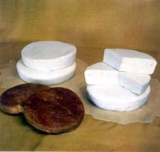
Suluguni
Encyclopedia

Georgian cheese
List of Georgian cheese:* Sulguni * Imeruli * Gouda...
from the Samegrelo
Samegrelo
Samegrelo/Samargalo or Megrelia, Mingrelia is a historic province in the western part of Georgia, formerly also known as Odishi.It is inhabited by the Megrelians, an ethnic subgroup of the Georgians.-Geography and Climate:...
region. It has a sour, moderately salty flavor, a dimpled texture, and an elastic consistency; these attributes are the result of the process used, as is the source of its moniker "pickle cheese". Its color ranges from white to pale yellow. Suluguni is often deep-fried, which masks its odor. It is often served in wedges.
A typical suluguni cheese is shaped as a flat disc, 2.5 to 3.5 centimeters thick. It weighs 0.5 to 1.5 kilograms and contains 50% water and between 1% and 5% salt. Dry fat content averages 45%. Suluguni is produced only of natural ingredients: normalized cow milk by clotting by rennet with pure cultures of lactic bacteria.
Etymology
The word may be TurkicTurkic languages
The Turkic languages constitute a language family of at least thirty five languages, spoken by Turkic peoples across a vast area from Eastern Europe and the Mediterranean to Siberia and Western China, and are considered to be part of the proposed Altaic language family.Turkic languages are spoken...
in origin. According to the entry in the Brockhaus and Efron Encyclopedic Dictionary
Brockhaus and Efron Encyclopedic Dictionary
The Brockhaus and Efron Encyclopedic Dictionary is, in its scope and style, the Russian counterpart to the Encyclopædia Britannica. It contains 121,240 articles, 7,800 images, and 235 maps...
"Sulug (Tatar languageTatar languageThe Tatar language , or more specifically Kazan Tatar, is a Turkic language spoken by the Tatars of historical Kazan Khanate, including modern Tatarstan and Bashkiria...
)—a type of cheese in Transcaucasia prepared from foremilk. For the preparation a sheep's afterbirth is taken, which is filled with foremilkColostrumColostrum is a form of milk produced by the mammary glands of mammals in late pregnancy. Most species will generate colostrum just prior to giving birth...
or viscous milk. The afterbirth is then tied up and buried in hot ashes. As a result, the foremilk and milk curdles and turns into a sweetish cheese that is called "sulug"."
This may also be a reverse borrowing.
Another theory (possibly a folk etymology) posits that the name suluguni comes from two Georgian words - suli (which means "soul") and guli (which means "heart").
Production
According to the 1970s sources, suluguni accounted for around 27% of cheese production in Georgia. It was the third most popular pickled cheese of the Soviet UnionSoviet Union
The Soviet Union , officially the Union of Soviet Socialist Republics , was a constitutionally socialist state that existed in Eurasia between 1922 and 1991....
, with 16.5% share in 1987 (after Bryndza
Bryndza
Bryndza is a sheep milk cheese made in Central and Eastern Europe. Recipes differ slightly across the countries.-Etymology:Brânză or brînză is the generic word for "cheese" in Romanian, there is no special type of cheese associated with it...
and Ossetian cheese).
Suluguni may be produced from normalized milk of cow, buffalo
Bubalus
Bubalus is a genus of bovines, whose English name is buffalo. Species that belong to this genus are:* Subgenus Bubalus** Water Buffalo, Bubalus bubalis*** Carabao, Bubalus bubalis carabanesis...
, sheep or goat, or a mix of these milks. It is a "quick cheese" maturing in just one or two days. The mix of normalized milk and bacterial starter is scalded at 36-38°C or, alternatively, rennet
Rennet
Rennet is a complex of enzymes produced in any mammalian stomach to digest the mother's milk, and is often used in the production of cheese. Rennet contains many enzymes, including a proteolytic enzyme that coagulates the milk, causing it to separate into solids and liquid...
ed without scalding. It is then cheddared in whey
Whey
Whey or Milk Serum is the liquid remaining after milk has been curdled and strained. It is a by-product of the manufacture of cheese or casein and has several commercial uses. Sweet whey is manufactured during the making of rennet types of hard cheese like cheddar or Swiss cheese...
at 34-35°C for up to five hours, reaching titratable acid
Titratable acid
Titratable acid is a term to describe acids such as phosphoric acid, sulfuric acid which are involved in renal physiology.It is used to explicitly exclude ammonium as a source of acid, and is part of the calculation for net acid excretion....
ity of 140-160°T.
The cheddared mass is then diced into pieces 1 to 3 centimeters long. They are heated to 60-80°C in a rotating mixer, either directly or with added whey or brine. Plasticizing of raw mass takes five to seven minutes. Direct dry plasticizing yields fatter, drier cheese with superior taste. Plasticized cheese mass is then cooled and drained of whey, and shaped by hand. Shaped cheeses are cured in cold (8-12°C), mildly acidic brine for 6 to 48 hours.

